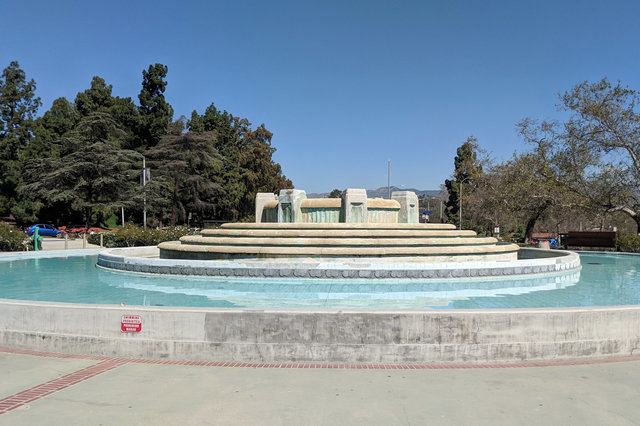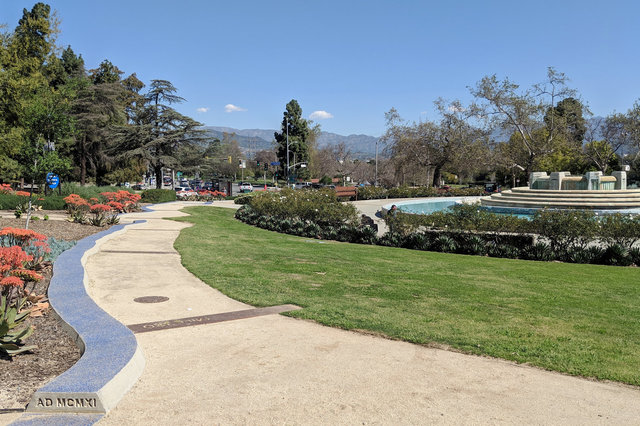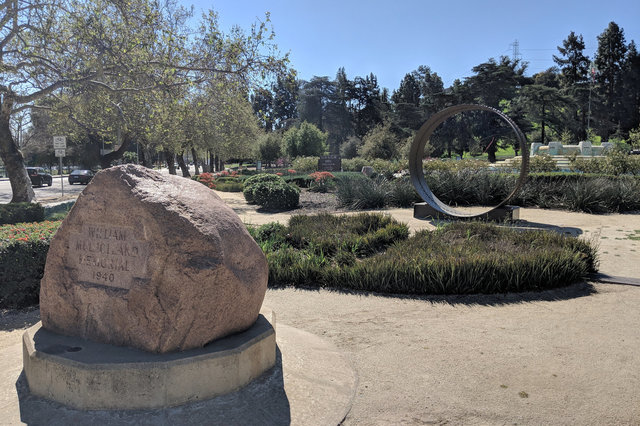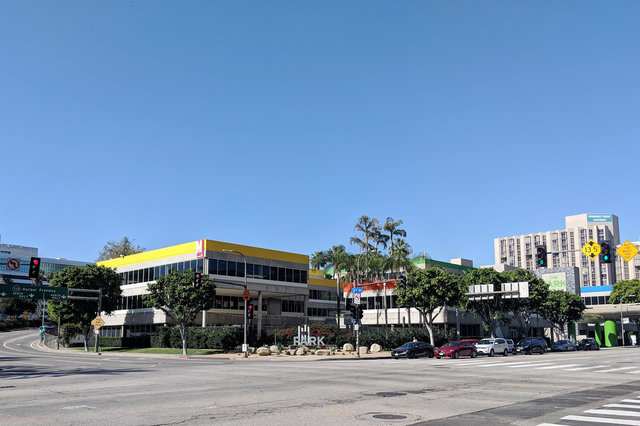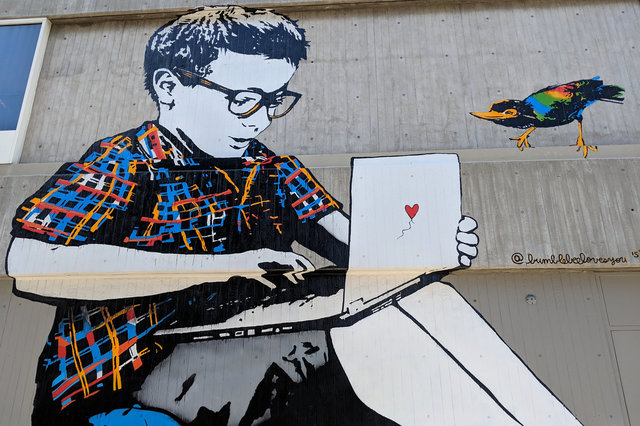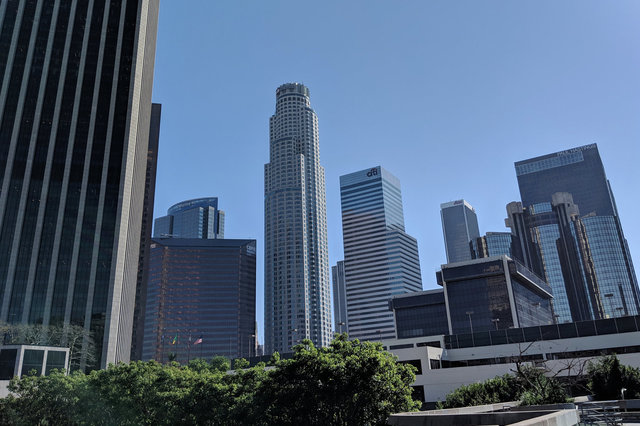And this ... is Marketplace
Started: 2019-04-28 17:51:35
Submitted: 2019-05-02 14:39:02
Visibility: World-readable
18 March 2019: In which the intrepid narrator visits Marketplace's studios in downtown Los Angeles
I was scheduled to visit Marketplace early in the afternoon, so I had the morning to myself in Los Angeles. I dropped by my employer's office in Venice Beach, mostly so I could claim credit for visiting the office in the internal system that tracks such things, and also to work on the timestamps on my backlog of photo sphere pictures I took on my most recent trip to Borrego Springs. (My camera ended up with a weird time drift; I suppose I should be happy that it records timestamps at all. And I guess I do know a thing or two about how accurate quartz crystals really are.)
I headed towards downtown Los Angeles, driving on the 10 to the 110 (past downtown) and then exited but followed the 5 towards Griffith Park. As I drove I noticed a small park dedicated to William Mulholland, chief engineer of the Los Angeles Water Department, and pulled over to visit the park.
It featured a large fountain (not currently running, possibly in consideration of California's drought status, but no doubt filled with pilfered water), surrounded by a walkway running down the gentle hillside showing the cities and waypoints crossed by the Los Angeles Aqueduct on it way from Owens Valley to the San Fernando Valley.
The park included a plaque bearing Mulholland's infamous quote from the opening of the aqueduct, "There it is. Take it!" which sums up Los Angeles' attitude to water from anywhere it can get its hands on it.
I was also interested to see a steel tunnel cross-section, placed on a plinth in the park in front of the fountain.
After my diversion, I returned to my originally-scheduled drive towards Griffith Park. I parked at the bottom of the hill and followed the dusty trail up the side of the hill under the bright spring sun. The steep grassy hillside was dotted with scrub oak trees, and it was immediately familiar to me in the way that many things in Southern California are: almost, but not entirely like, the things I know from the Bay Area.
At the top of the hill I found my destination: Griffith Observatory, also on my very short list of places I remember visiting in Los Angeles from some vague childhood memory. The observatory was closed on Monday, but I joined the crowds of people walking around the outside of the building, standing on the ramparts of the building looking out over the smog hanging visibly over Los Angeles below. Though they were only a few miles away, the high-rise towers of downtown Los Angeles were reduced to silhouettes in the morning haze, as the suburban sprawl stretched as far as I could see to the east and the west, finally terminating at the Pacific Ocean I could barely see.
Behind the observatory, on the other side facing away from the city, the Hollywood sign stood out from the hillside, more visible above the haze than downtown Los Angeles, complete with tourists vying to take their pictures in front of it. The hillside was briefly green from the spring rains; I had no doubt it would revert to its normal golden (brown) color soon.
Since the observatory was, in fact, an observatory, its grounds included various astronomical phenomena, including a spire with statues of astronomers cut into it, lines showing where the sun would rise an set on various important days of the year (including the equinox, a few days in the future), and diagrams representing the orbit of the planets of the solar system.
I was pleased to see that Pluto's orbit was still shown on the ground. The planet I grew up with may have been demoted but it still holds a place in my heart.
I descended the hill, returned to my car, and stopped for lunch at a little cafe in the neighborhood at the bottom of the hill.
I drove into downtown Los Angeles to the offices and studios of Marketplace, in a brightly-colored office park of three- and four-story buildings nestled next to the 110 freeway, a few blocks from the much-higher high-rise buildings of downtown Los Angeles. My contact Susan was waiting for me. She signed me in as a visitor and took me on a tour around the office, starting with the main studio where the radio program is broadcast. The engineers were running around getting ready for the show but took time to show me the key parts of the control room, including the number pad that cues the music that plays during the show -- especially "The Numbers" music, coordinated with how the market did during the day. I was surprised to see that the main mixer board had only sixteen channels; I was expecting many more channels to control all of the possible inputs, but each input was programmable so it could select from a much bigger set of possible inputs.
I walked into the studio, where host Kai Ryssdal broadcasts the show, complete with live video feeds from the other Marketplace studios in other cities.
Susan took me around the office, pointing out the offices and cubicles of various people involved in the show, many of whose names I recognized from hearing their names (or their voices) on the show every day. I talked to some of the reporters, and tried to get a better idea of what the process looks like to put the show together every day. (All I hear is the finished product, the disembodied voices coming across my earbuds as I walk home or do the dishes.) At one point I saw an Emmy award trophy, sitting in a pile of awards on an unused cubicle desk, awarded to Marketplace for one of their in-depth reporting projects in collaboration with PBS.
We returned to the open space in the office in front of the studio in time for the day's show at 14:00. Some radio stations (mostly on the east coast) pick up the 14:00 show live; most pick up the follow-up rebroadcast that fixes some glitches from the first recording. (Every once and a while, news breaks while the show is live and the entire thing gets recorded again.) Susan sat me on the bar overlooking the control room, from which I could catch a glimpse into the studio, but carefully positioned to avoid distracting Kai while he was hosting. I could hear the final mix through the speakers outside the studio, and see the recording engineer and producer inside the control room set up the interstitial music and the pre-recorded segments, execute the mix, and cue Kai to start talking when the time was right.
When I heard Kai say "And this ... is Marketplace", words I've heard for years but never live and in person (despite being separated by several panes of sound-proofing glass) I was transfixed by the show and the effort that went into making it sound effortless.
One of the show's segments was a previously-recorded phone interview between Kai and a businessperson from Nebraska, and to explain some of the interview, Kai cut into the recorded interview to talk, live, in between the recorded interview. Listening to the audio it was barely obvious that was happening, only that some of the sentences were Kai talking directly to the audience rather than to the subject of the interview.
And then the show was over, and I talked to Susan and one of the show's senior leaders, when Kai wrapped up in the studio and broke in to say hi, then headed off to his office.
And with that, my visit to Marketplace was complete, a whirlwind of public radio business reporting in sunny Los Angeles. I was excited to have had the opportunity to visit the studio, and meet the people and see how it all comes together live every weekday afternoon.
While I was in downtown Los Angeles, I walked a few blocks (past a colorful mural on the rough concrete wall) to the Los Angeles Public Library, down sidewalks surrounded by massive concrete walls towering above me broken only by gaping dark voids granting cars access to the sprawling parking garages. For a moment it was so weirdly dystopian that I thought I had stepped into Blade Runner; then I crossed the street and found myself face-to-face with the imposing (and hard-to-photograph) facade of the central library, which felt like a regular big city with a tiny park and people, bustling around or not as they chose.
I looked around the library, then returned to my car and drove west, back to my hotel in Marina Del Mar. After two days in Los Angeles I was already tired of the endless sprawl and the crowded freeways that never seemed to be going the same direction I wanted to go. But I enjoyed the sun, and the food, and being near the ocean.
In the evening I drove to Santa Monica, walked along the pier to the end, past the crowds vying for a position to watch the setting sun.
As the sun dropped below the horizon I left the beach in search of tacos; and, properly fortified, returned to my hotel before returning to Seattle the next day.
